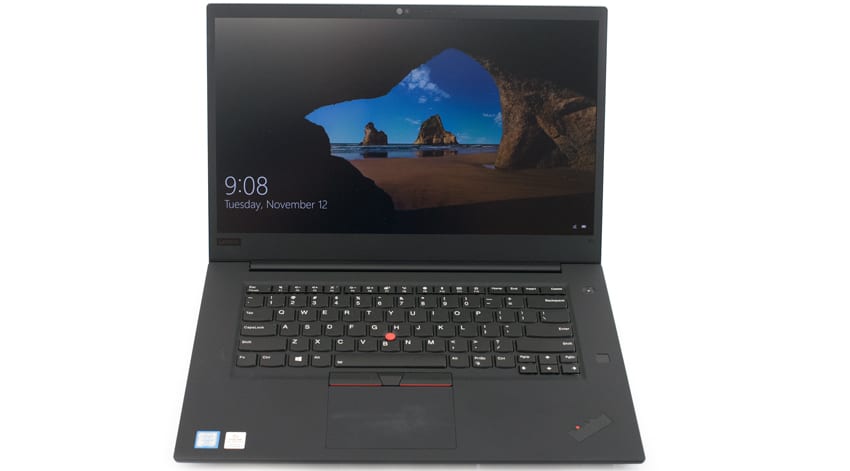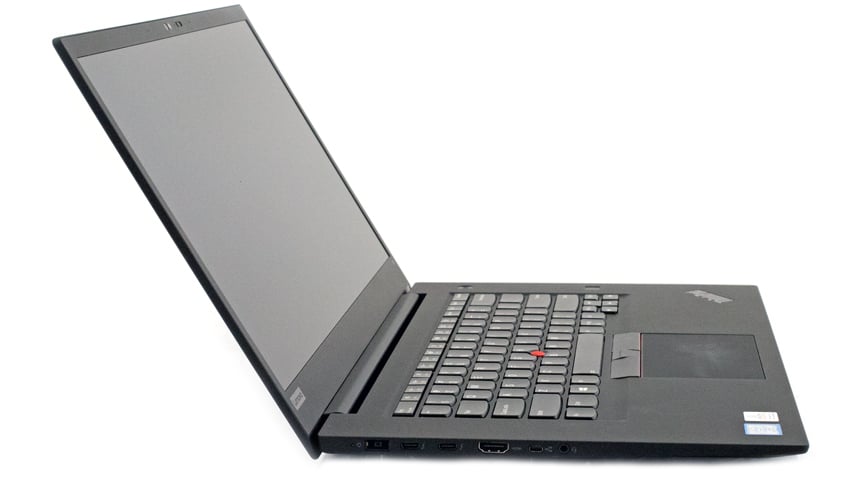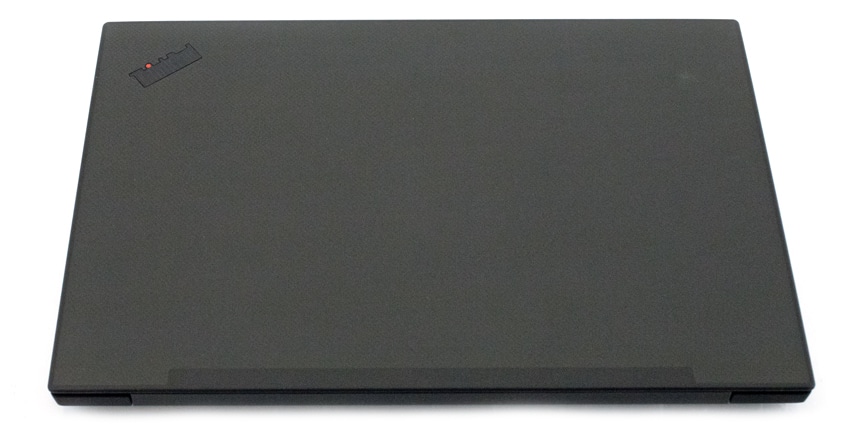Lenovo released the next generation of it’s P Series portfolio, their most powerful line of laptops. We recently reviewed the ThinkPad P53. Today we’re reviewing another laptop in the portfolio, the ThinkPad P1 Gen 2, and looking at what this workstation has to offer. The P1 returns fulfilling the desire for a thin and light design backed by workstation performance. This generation’s spec refresh delivers new levels of power with the latest Intel processors (up to eight cores), NVIDIA Turing graphics, new display options including an OLED Touch display, and X-Rite Pantone Factory color calibration. At top configuration, this workstation can be decked out with 9th generation Intel Xeon E or Core H-series processors, up to NVIDIA Quadro T2000 graphics, a 15.6” OLED Touch Display with Dolby Vision HDR, 64 GB DDR4 memory, and 4TB PCIe NVMe SSD storage.

There’s more than power packed into the slim chassis of the ThinkPad P1 Gen 2. It delivers universal connectivity with two Thunderbolt 3 ports, as well as USB 3.1 and HDMI ports, minimized downtime thanks to a large 80WHr long-lasting battery with rapid charge technology, and vivid visuals made possible by technologies including Dolby Vision and X-Rite Calibration. Additional standout features of the P1 include a new carbon fiber top cover which provides durability and weight advantages, Mil-Spec certification, ISV certifications, Dolby Audio, 360-degree far-field microphones, and an extremely portable power adapter.
The unit we were given to review came equipped with an Intel Core i7-9850H processor, NVIDIA Quadro T2000 4GB GDDR5 graphics, 32GB DDR4 non-ECC memory, 2TB SSD M.2 2280 PCIe NVMe Opal2 storage, and 15.6” UHD (3840×2160) IPS 500nits Anti-Glare w/ Dolby Vision HDR display. Pricing for the ThinkPad P1 Gen 2 starts at $1,829; however, with these specs expect to pay more.
Lenovo ThinkPad P1 Gen 2 Specifications
| Processors | Intel Xeon E (E-2276M) 9th Generation Intel Core i9 (i9-9880H) 9th Generation Intel Core i7 (i7-9750H, i79850H) 9th Generation Intel Core i5 (i5-9400H) |
| Operating System | Windows 10 Pro for Workstations Windows 10 Pro Windows 10 Home Ubuntu Linux (pre-load) Redhat Linux (certified) |
| Chipset | Intel CM246 |
| Maximum Memory | Maximum Capacity: Up to 64GB DDR4 Type: ECC & non-ECC Speed: 2667MHz |
| Memory Slots | 2 SODIMM slots |
| Available Graphics | |
| Integrated | Intel UHD Graphics 630 Intel UHD Graphics P630 |
| Discreet | NVIDIA Quadro T2000 4GB GDDR5 NVIDIA Quadro T1000 4GB GDDR5 |
| Display Options | 15.6″ FHD (1920 x 1080) IPS, 300 nits, anti-glare, 72% NTSC 15.6″ FHD (1920 x 1080) IPS, 500 nits, anti-glare with Dolby Vision HDR, 72% NTSC 15.6″ UHD (3840 x 2160) IPS, 500 nits, anti-glare with Dolby Vision HDR, 100% ADOBE 15.6″ UHD (3840 x 2160) OLED, 400 nits, AR/AS, multi-touch Dolby Vision HDR, 100% DCI-P3 |
| Camera | HD Camera with ThinkShutter Hybrid IR Camera with ThinkShutter |
| Storage Options | M.2 PCIe-NVMe Opal Solid State Drive
|
| Maximum Storage | Up to 4TB NVMe SSD Up to 2 Hard Drives |
| Raid | 0,1 |
| Communications | |
| WLAN | Intel WI-FI 6 AX200 (Gig+) + Bluetooth 5.1 vPRO |
| WWAN | None |
| Audio | HD Audio, Synaptic CX11880 codec / stereo speakers, 2W x 2, Dolby Audio Premium / dual array far-field microphone, headphone / microphone combo jack, Dolby Atmos sound system |
| I/O Ports and Connectors | |
| Left | 2x USB-C Thunderbolt 3 1x HDMI 2.0 1x Mini Gigabit Ethernet 1x Mic/Headphone Combo Jack |
| Right | 2x USB-A 3.1 Gen 1, 1 Always On 1x Smart Card Reader |
| Media Card Reader | 4-in-1 SD Card Reader |
| Physical | |
| Dimensions (WxDxH) | 361.8×245.7×18.4 (mm) |
| Weight | Starting at 3.74lbs (1.7kg) |
| Power | |
| Battery | 80WHr |
| Power Supply | 135W Slim |
| Certifications | ArcGIS, AutoCAD, CATIA, Creo, Inventor, Microstation, NX, PDMS, Revit, Solid Edge, SolidWorks, Vectorworks |
| Warranty | Limited configurable by model: 1-year depot repair service 1-year depot with 2-year planar repair service 3-year/1-yr battery depot repair service 3-year/1-yr battery limited onsite service |
Design and Build
The Lenovo ThinkPad P1 Gen 2 boasts new levels of power with differences you can see and hear. The high-end design of this mobile workstation features Lenovo’s signature black finish, glass touchpad, and seamless keyboard. A new top cover with a carbon fiber weave design is available on devices equipped with the UHD display panels. The bottom cover is constructed of an aluminum alloy to keep it running cool. With weight starting at 3.74lbs and a thinness of 18.4mm, everything in the design of the P1 is hinged upon supporting the thin and light form factor. Further emphasizing attention to detail and weight reduction even the power supply is 35% smaller and lighter. Like all ThinkPads, the P1 has been durability tested passing many of Lenovo’s in-house tests as well as 12 MIL-STD 810G tests.
Satisfy your senses with the audio and display options that the P1 Gen 2 offers. This year there are 500-nit displays at a variety of resolutions as well as an OLED display option. The Dolby Vision OLED display is a 15-inch 4K UHD touchscreen panel representing 100% of the Adobe color gamut, with IR camera standard. It displays the most true-to-life colors the human eye can perceive. For those in the entertainment and design industry where color accuracy is a top priority, the P1 now offers the option of a pre-calibrated factory set display, restorable anytime from the cloud, that is backed and certified by X-Rite. With X-Rite Pantone color calibration what you see on the screen will be exactly how it looks when printed. However, this calibration feature is only available on the UHD (IPS or OLED) panels. With the Dolby Atmos speaker system and dual far-field microphones, the display is matched with an audio experience ideal for listening to music or a conference call.

Small stature doesn’t mean limited connectivity. There’s a lot packed into the ultrathin chassis of the P1. Looking at the connectivity of this workstation the connectors are pretty evenly split between the left and the right sides. The left side features power input, two USB-C Thunderbolt 3, an HDMI port, an RJ45 Ethernet extension connector, and a headphone/mic combo. The right side features a Smart Card Reader (optional), SD card reader, two USB-A 3.1 (1 always-on), and a Kensington lock slot.

Lastly, this workstation has been built to keep you connected and up and running. An 80 watt-hour internal battery keeps the workstation powered up to 13 hours. For demanding tasks that drain your system, Lenovo’s Rapid Charge technology will bring you back up to 80% capacity in just an hour. Also, with WIFI-6 built-in you’ll have the fastest WIFI available with speeds up to 9.6Gbps.
Below are the specs on all GPUs available for the ThinkPad P1 (Gen 2).
*NVIDIA Quadro T2000 Specifications:
- GPU Architecture: NVIDIA Turing
- Single-Precision Performance: Up to 3.5 TFLOPS
- NVIDIA Cuda Cores: 1,024
- Memory Configuration: 4GB GDDR5
- Memory Bandwidth: Up to 128 GB/s
- Display Output Connectors: DisplayPort 1.4
- Board Form Factor and Length: x
- Thermal Solution: Active
- Max Power Consumption: 40 – 60 W
- VR Ready: No
*NVIDIA Quadro T1000 Specifications:
- GPU Architecture: NVIDIA Turing
- Single-Precision Performance: Up to 2.6TFLOPS
- NVIDIA Cuda Cores: 768
- Memory Configuration: 4GB GDDR5
- Memory Bandwidth: Up to 128 GB/s
- Display Output Connectors: DisplayPort 1.4
- Board Form Factor and Length: x
- Thermal Solution: Active
- Max Power Consumption: 40 – 50 W
- VR Ready: No
*No datasheets were available for the NVIDIA Quadro T2000 or T1000. Information was taken from the Quadro mobile line card published in August of 2019.
Performance:
We put the Lenovo ThinkPad P1 Gen 2 through three resource intensive tests to see what it can do as well as test the capabilities of the Nvidia Quadro T2000. This first test is the SPECviewperf 13 benchmark, which is the worldwide standard for measuring graphics performance based on professional applications. SPECviewperf runs 9 benchmarks called “viewsets,” which represent graphics content and behavior from actual applications and include categories such as 3D Max, CATIA, Creo, Energy, Maya, Medical, Showcase, Siemens NX, and Solidworks.
| SPECviewperf 13 | ||
|---|---|---|
| Viewsets | ThinkPad P1 Gen 2 Intel Core i7-9850H NVIDIA Quadro T2000 |
ThinkPad P53 Intel Xeon E-2276M NVIDIA Quadro RTX 5000 |
| 3dsmax-06 | 94.64 | 100.26 |
| Catia-05 | 148.46 | 270.88 |
| Creo-02 | 121.19 | 270.07 |
| Energy-02 | 15.52 | 38.01 |
| Maya-05 | 123.36 | 280.62 |
| Medical-02 | 42.32 | 91.97 |
| Showcase-02 | 35.02 | 95.66 |
| Snx-03 | 269.85 | 615.52 |
| Sw-04 | 115.52 | 165.60 |
Next, we ran SPECworkstation3, a test that specializes in benchmarks designed for testing all key aspects of workstation performance; it uses over 30 workloads to test CPU, graphics, I/O, and memory bandwidth. The workloads fall into broader categories such as Media and Entertainment, Financial Services, Product Development, Energy, Life Sciences, and General Operations. We are going to list the broad-category results for each, as opposed to the individual workloads. The results are an average of all the individual workloads in each category.
| SPECworkstation3 | ||
|---|---|---|
| Category | ThinkPad P1 Gen 2 Intel Core i7-9850H NVIDIA Quadro T2000 |
ThinkPad P53 Intel Xeon E-2276M NVIDIA Quadro RTX 5000 |
| M&E | 1.74 | 2.00 |
| ProdDev | 2.17 | 2.21 |
| LifeSci | 1.70 | 1.76 |
| Energy | 1.22 | 1.27 |
| FSI | 1.21 | 1.59 |
| GeneralOps | 1.94 | 1.96 |
| GPU Compute | 1.70 | 3.37 |
The last of the tests is the Environmental Systems Research Institute (Esri) benchmark. Esri is a supplier of Geographic Information System (GIS) software. Esri’s Performance Team designed their PerfTool add-in scripts to automatically launch the ArcGIS Pro. This application uses a “ZoomToBookmarks” function to browse various predefined bookmarks and create a log file with all the key data points required to predict the user experience. The script automatically loops the bookmarks three times to account for caching (memory and disk cache). In other words, this benchmark simulates heavy graphical use that one might see through Esri’s ArcGIS Pro software.
The tests consist of three main datasets. Two are 3-D city views of Philadelphia, PA and Montreal, QC. These city views contain textured 3-D multipatch buildings draped on a terrain model and draped aerial images. The third dataset is a 2-D map view of the Portland, OR region. This data contains detailed information for roads, land use parcels, parks and schools, rivers, lakes, and hill shaded terrain.
Looking at drawtime of the Montreal model, the Lenovo ThinkPad P1 showed an average drawtime of 00:01:30.209, while average and minimum FPS showed 330.35 and 160.68.
| ESRI ArcGIS Pro 2.3 Montreal | |
|---|---|
| Drawtime | Average |
| ThinkPad P1 Gen 2 | 00:01:30.209 |
| ThinkPad P53 | 00:01:30.152 |
| Average FPS | Average |
| ThinkPad P1 Gen 2 | 330.35 |
| ThinkPad P53 | 569.44 |
| Minimum FPS | Average |
| ThinkPad P1 Gen 2 | 160.68 |
| ThinkPad P53 | 228.08 |
Next up is our Philly model, where the ThinkPad P1 showed an average drawtime of 00:01:00.200, while average and minimum FPS showed 223.58 and 127.94.
| ESRI ArcGIS Pro 2.3 Philly | |
|---|---|
| Drawtime | Average |
| ThinkPad P1 Gen 2 | 00:01:00.200 |
| ThinkPad P53 | 00:01:00.317 |
| Average FPS | Average |
| ThinkPad P1 Gen 2 | 223.58 |
| ThinkPad P53 | 435.91 |
| Minimum FPS | Average |
| ThinkPad P1 Gen 2 | 127.94 |
| ThinkPad P53 | 205.38 |
Our last model is of Portland. Here, the P1 had an average drawtime of 00:00:30.434. Average FPS showed 3,404.87 while Minimum FPS showed 1,289.47.
| ESRI ArcGIS Pro 2.3 Portland | |
|---|---|
| Drawtime | Average |
| ThinkPad P1 Gen 2 | 00:00:30:434 |
| ThinkPad P53 | 00:00:30.395 |
| Average FPS | Average |
| ThinkPad P1 Gen 2 | 3,404.87 |
| ThinkPad P53 | 4,246.73 |
| Minimum FPS | Average |
| ThinkPad P1 Gen 2 | 1,289.47 |
| ThinkPad P53 | 1,484.11 |
Conclusion
The Lenovo ThinkPad P1 Gen 2 has the power you need and the mobility that you want. At 3.74 pounds and 18.4 mm thin it is Lenovo’s thinnest and lightest 15-inch workstation. It brings new levels of power with the latest NVIDIA Quadro T1000 and T2000 GPUs. However, while the new graphics cards are built on Turing architecture they are not capable of supporting VR or AI. Display options have been elevated with the options of X-Rite Pantone Factory Color Calibration and the 4K UHD Dolby Vision HDR OLED display panel. Durability is on par with expectation and MIL-STD810G certification plus Lenovo’s quality checks ensure suitability for even the most extreme environments. Connectivity options are comprehensive and highlighted by the existence of two USB-C Thunderbolt 3 ports, two USB-A 3.1 ports, and an HDMI. Although, connectivity isn’t dongle free due to the mini gigabit ethernet. You’ll need some sort of dongle, extender, hub, or dock for an ethernet connection. The 80 watt-hour battery provides up to 13 hours of use and with Rapid Charge capability you can have almost another full charge in 60 minutes.
At top configuration, this workstation offers 9th generation Intel Xeon E or Core H-series processors, up to NVIDIA Quadro T2000 graphics, a 15.6” OLED Touch Display with Dolby Vision HDR, 64 GB DDR4 memory, and 4 TB PCIe NVMe SSD storage.
Looking at performance results the Lenovo ThinkPad P1 Gen 2 performed well as an entry-level workstation. Comparing the P1 to the P53 simply illustrates the performance gains that can be seen from up-market workstations equipped with top-market products versus a lighter workstation outfitted with more affordable mid-market options. The ThinkPad P1 Gen 2 is aimed at entry to midrange technical users and delivers great performance for the target audience. It produced solid scores on all the tests we ran. Performing most closely to the P53 in our SPECworkstation3 test load outside of the GPU compute. Additionally, it pulled a faster drawtime for our ESRI Philly test. Overall, this machine is a lean mean workstation with great performance without the bulk.




 Amazon
Amazon